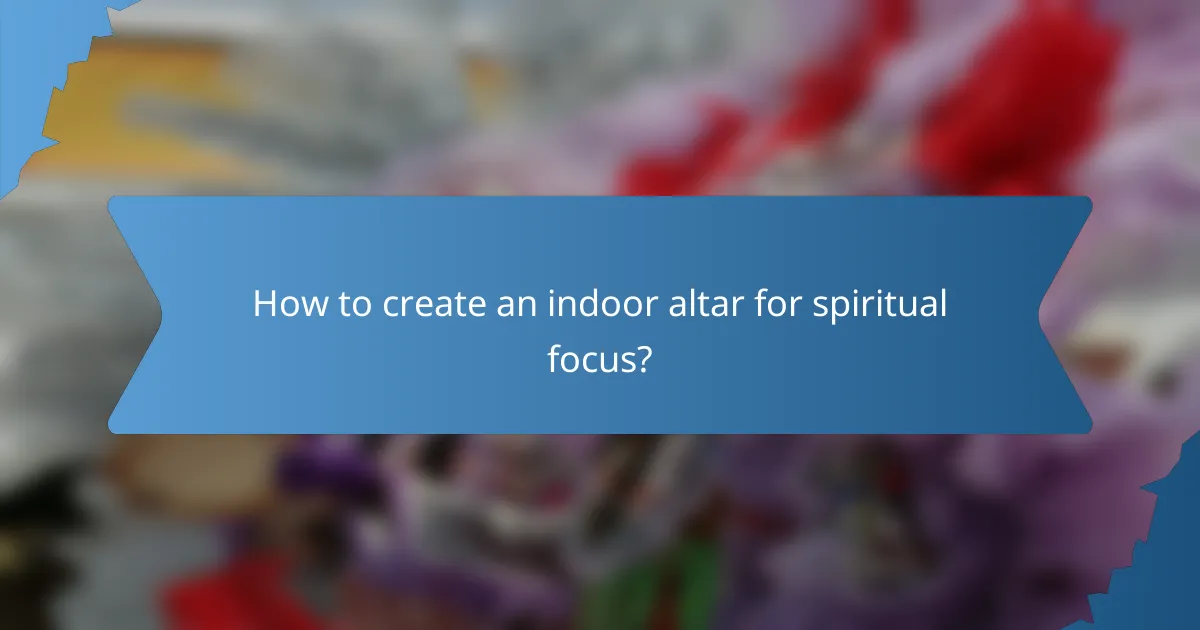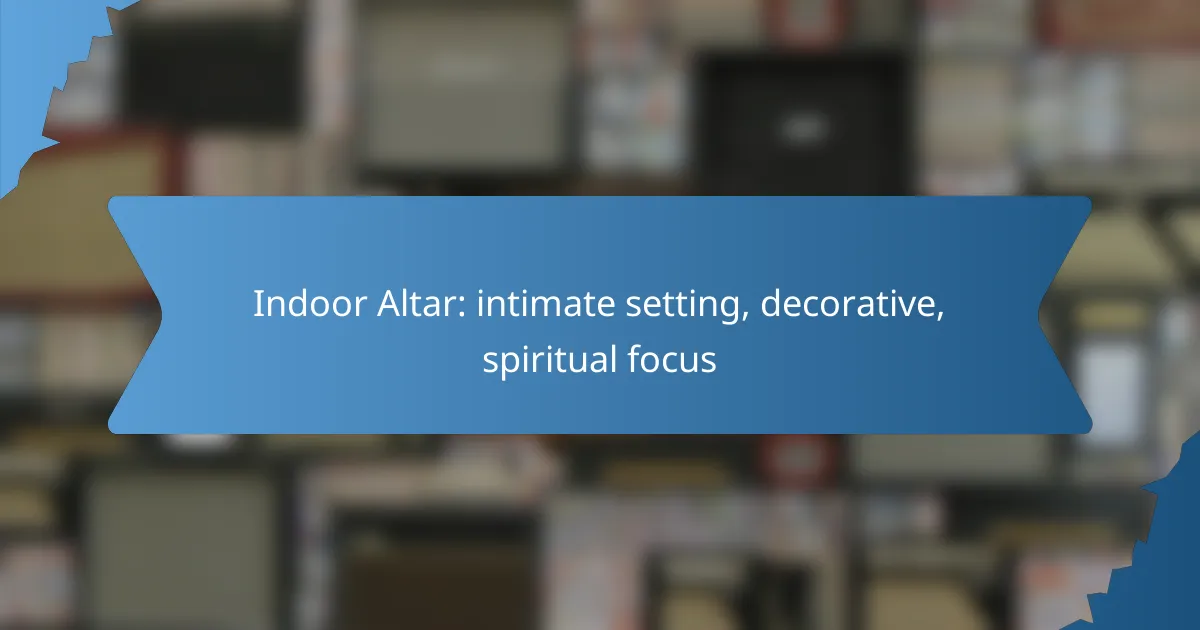An indoor altar serves as a dedicated space within your home for spiritual practice, allowing you to focus your intentions and connect deeply with your beliefs. By carefully selecting meaningful decor and symbols, you can create an intimate setting that reflects your personal spirituality and enhances your overall experience.

How to create an indoor altar for spiritual focus?
Creating an indoor altar involves selecting a specific area in your home dedicated to spiritual practice, where you can focus your intentions and connect with your beliefs. This space should reflect your personal spirituality through meaningful decor and symbols that resonate with you.
Choose a dedicated space
Select a quiet corner or a room in your home that feels peaceful and conducive to reflection. This space should be free from distractions and clutter, allowing you to concentrate fully on your spiritual practices. Consider areas with natural light or a view of nature to enhance the ambiance.
Make sure the space is accessible and comfortable, as you may spend significant time there. A small table, shelf, or even a designated floor area can serve as the altar’s base.
Select meaningful decor items
Choose decor items that resonate with your spiritual beliefs and practices. Common items include candles, crystals, incense, and images of deities or spiritual figures. Each item should hold significance, helping to create an atmosphere that supports your spiritual focus.
Consider incorporating natural elements like plants or stones, which can enhance the connection to the earth and promote a calming environment. Aim for a balance between aesthetics and functionality, ensuring that each piece contributes to the overall purpose of the altar.
Incorporate personal symbols
Personal symbols can deepen your connection to the altar. These might include photographs, heirlooms, or objects that represent your journey or aspirations. Each symbol should evoke a sense of peace or inspiration when you see it.
Think about what has meaning for you—this could be anything from a favorite book to a handmade item. The goal is to create a space that feels uniquely yours and encourages introspection.
Use appropriate lighting
Lighting plays a crucial role in setting the mood for your altar. Soft, warm lighting can create a serene atmosphere, while candles can add a sacred element to your practice. Consider using dimmable lights or lamps with adjustable brightness to tailor the environment to your needs.
Be mindful of safety when using candles; ensure they are placed securely and never left unattended. If you prefer electric lighting, opt for bulbs that mimic the warmth of candlelight for a similar effect.
Maintain a clean environment
A clean altar promotes clarity and focus. Regularly dust and organize the space to keep it inviting and functional. Remove items that no longer resonate with you or that feel cluttered, allowing the altar to evolve with your spiritual journey.
Consider setting a routine for maintenance, such as weekly cleaning or monthly re-evaluations of the items on your altar. This practice not only keeps the space tidy but also encourages ongoing reflection and intention-setting.

What materials are best for indoor altars?
Choosing the right materials for indoor altars is essential for creating a meaningful and inviting space. Common options include wood, stone, and fabric, each offering unique qualities that enhance the altar’s spiritual focus and aesthetic appeal.
Wood for warmth and connection
Wood is a popular choice for indoor altars due to its natural warmth and ability to foster a sense of connection. Different types of wood, such as oak, pine, or cedar, can evoke various feelings and energies, making it important to select one that resonates with your spiritual intentions.
When incorporating wood, consider its finish and texture. A smooth, polished surface may convey elegance, while a rough, unfinished piece can emphasize authenticity and grounding. You can also enhance the altar with wooden carvings or symbols that reflect your beliefs.
Stone for stability and grounding
Stone materials provide a sense of stability and grounding, making them ideal for indoor altars. Common choices include granite, marble, or even crystals, each offering different energetic properties. For example, amethyst is often associated with tranquility, while clear quartz is known for its amplifying qualities.
When selecting stone for your altar, think about the weight and permanence of the material. Heavier stones can create a solid foundation, while lighter options may allow for more versatility in arrangement. Ensure that the stone complements the overall aesthetic of your altar.
Fabric for softness and comfort
Fabric adds a layer of softness and comfort to indoor altars, making the space more inviting. Common fabrics include cotton, silk, or linen, which can be used as altar cloths or decorative elements. The choice of color and texture can significantly influence the atmosphere of the altar.
When using fabric, consider layering different textures and colors to create visual interest. For instance, a soft cotton cloth can serve as a base, while a silk scarf can be draped for added elegance. Ensure that the fabrics are clean and well-maintained to preserve the altar’s sacredness.

How to personalize your indoor altar?
Personalizing your indoor altar involves selecting items and colors that resonate with your spiritual journey and personal history. This creates a meaningful space that reflects your beliefs and emotions, enhancing your connection to the altar.
Add family heirlooms
Incorporating family heirlooms into your indoor altar can deepen its significance. These items often carry stories and memories, making your altar a tribute to your lineage and personal history.
Consider using items like antique jewelry, handmade crafts, or even small trinkets passed down through generations. Each piece can serve as a focal point for reflection and connection to your ancestors.
Incorporate favorite colors
Your favorite colors can enhance the atmosphere of your indoor altar, making it more inviting and personal. Colors can evoke specific emotions and energies, so choose shades that resonate with your spiritual intentions.
For example, calming blues and greens can promote tranquility, while vibrant reds and yellows can inspire energy and passion. Use these colors in fabrics, candles, or decorative elements to create a harmonious space.
Include photographs of loved ones
Photographs of loved ones can serve as powerful reminders of the connections that enrich your life. Including these images on your altar can foster a sense of presence and support during your spiritual practices.
Choose photos that evoke positive memories or represent significant relationships. You might also consider using small frames or decorative holders to display these images beautifully, integrating them into your altar’s overall design.

What are the benefits of having an indoor altar?
Having an indoor altar offers numerous benefits, including enhancing spiritual practices, creating a calming environment, and encouraging mindfulness. These elements contribute to a more focused and serene space for personal reflection and connection with one’s beliefs.
Enhances spiritual practice
An indoor altar serves as a dedicated space for spiritual activities, such as meditation, prayer, or rituals. By having a specific area for these practices, individuals can cultivate a deeper connection to their spirituality and make these activities a regular part of their routine.
To enhance spiritual practice, consider incorporating meaningful items like candles, crystals, or religious symbols that resonate with your beliefs. This personalization can transform the altar into a powerful focal point for your spiritual journey.
Creates a calming environment
Indoor altars can significantly contribute to a calming atmosphere in your home. The visual appeal of an altar, adorned with natural elements and soft lighting, can promote relaxation and tranquility.
To create a soothing environment, choose a quiet corner of your home and arrange your altar thoughtfully. Use colors and materials that evoke peace, such as soft blues or greens, and incorporate elements like plants or flowing fabrics to enhance the serene ambiance.
Encourages mindfulness and reflection
Having an indoor altar encourages mindfulness by providing a space dedicated to reflection and contemplation. This practice can help individuals slow down, focus on their thoughts, and engage in self-discovery.
To foster mindfulness, set aside regular time to sit by your altar, engage with its elements, and reflect on your thoughts and feelings. This routine can deepen your understanding of yourself and your spiritual path, making it a valuable practice in daily life.

What are common themes for indoor altars?
Common themes for indoor altars often reflect personal beliefs, values, and aesthetics. They can range from nature-inspired elements to religious symbols, each creating a unique spiritual focus that enhances the atmosphere of the space.
Nature-inspired themes
Nature-inspired themes for indoor altars emphasize the beauty and tranquility of the natural world. Incorporating elements like stones, plants, flowers, or water can create a serene environment that fosters meditation and reflection.
When designing a nature-themed altar, consider using items that resonate with you personally. For example, you might choose crystals that align with your intentions or seasonal flowers that bring freshness and vitality. Aim for a balanced arrangement that feels harmonious and inviting.
Religious or spiritual symbols
Religious or spiritual symbols serve as focal points for many indoor altars, representing beliefs and practices that are meaningful to the individual. Common symbols include crosses, statues, candles, and sacred texts, each contributing to the altar’s spiritual significance.
To create an altar rich in spiritual symbolism, select items that reflect your faith or spiritual path. For instance, if you follow a specific religion, include icons or artifacts that are traditional within that practice. Ensure that the arrangement is respectful and thoughtfully curated, enhancing your spiritual experience.
